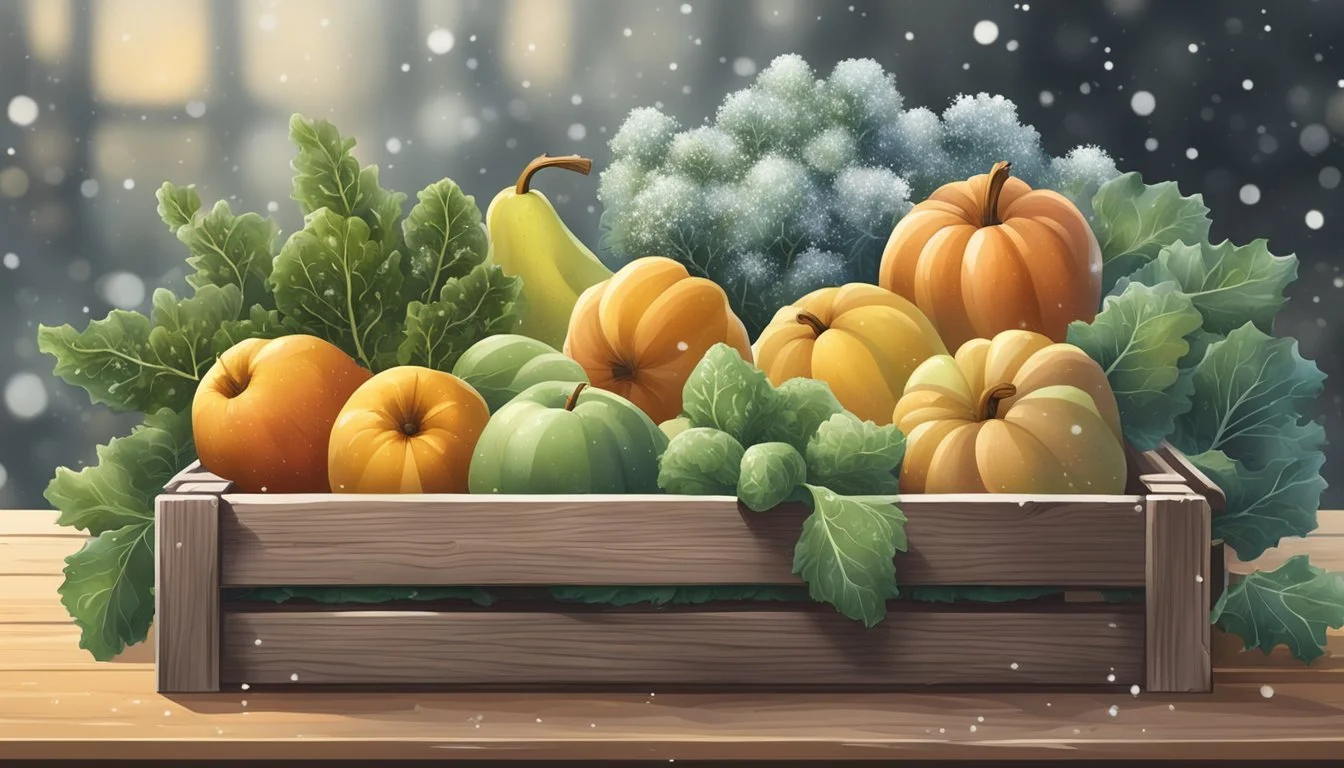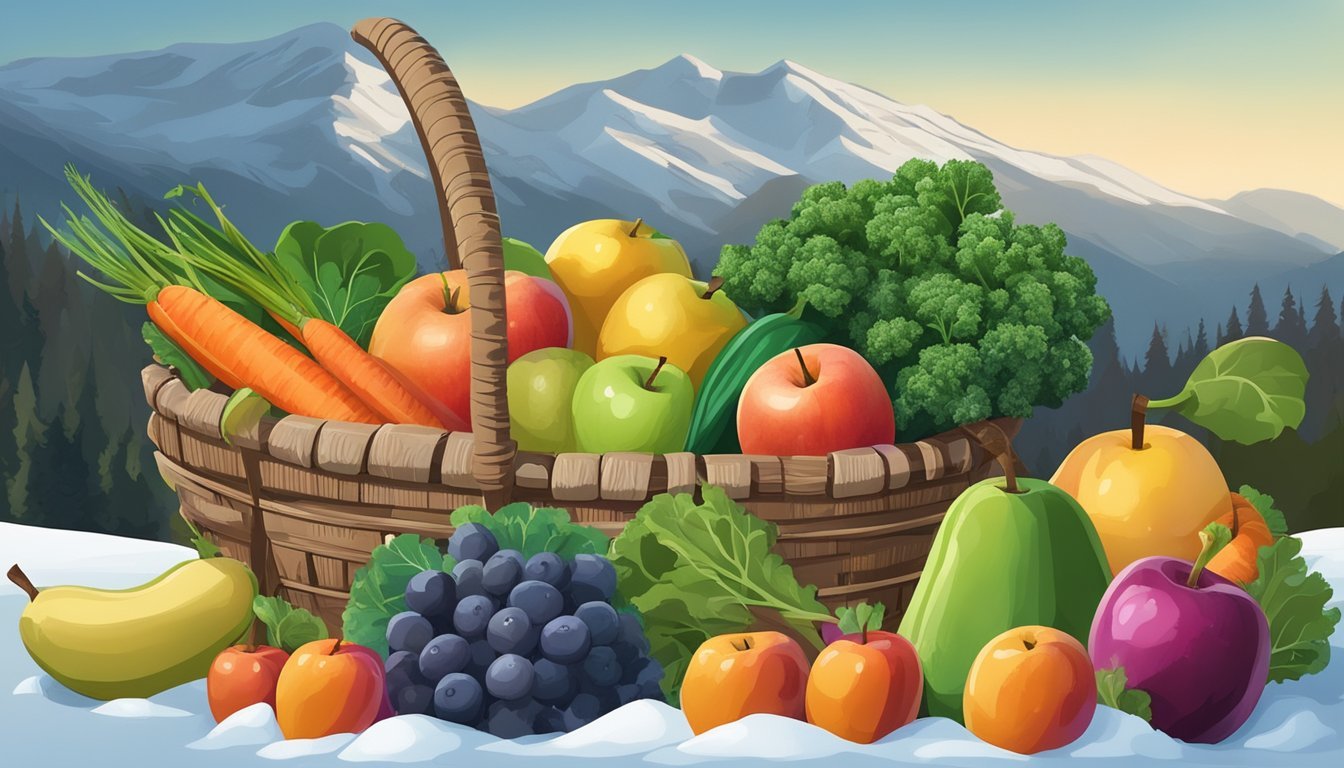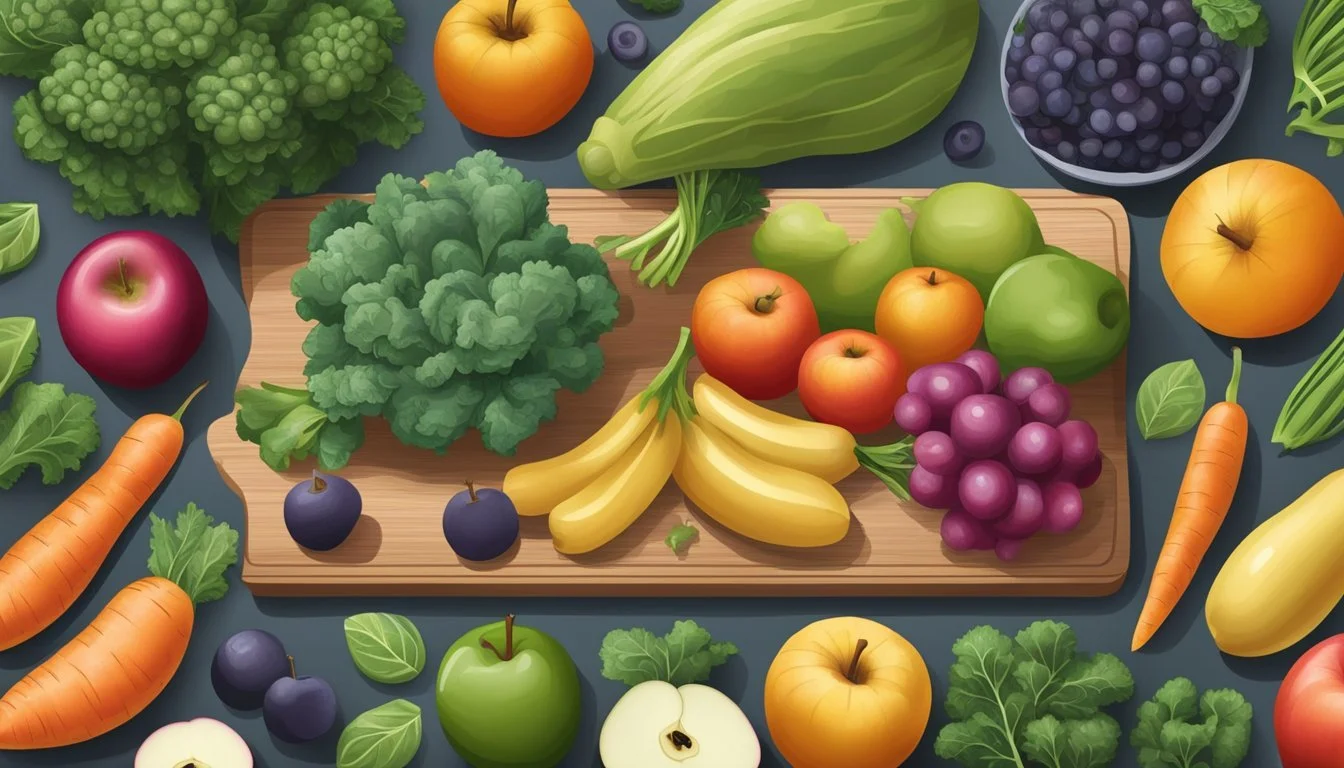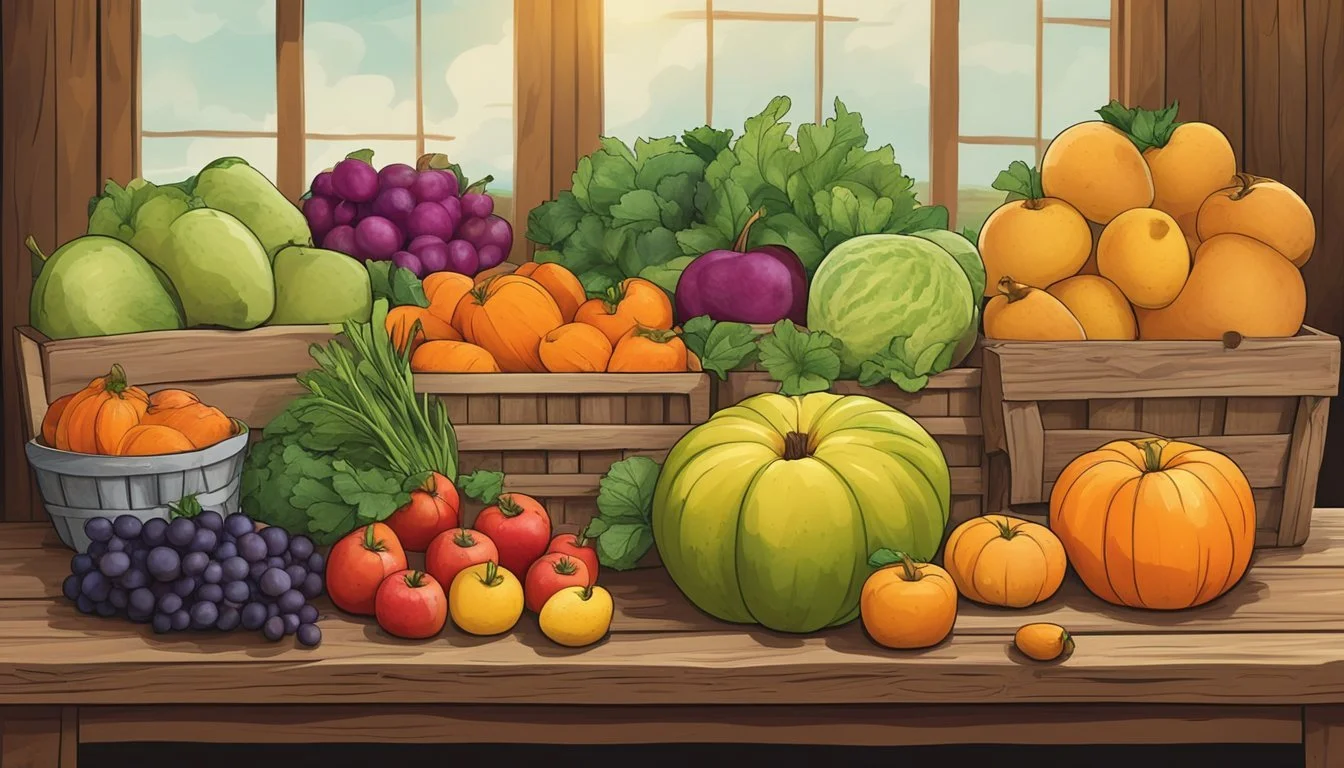Montana Seasonal Fruit & Vegetables in January
Your Guide to Winter Produce
This Article is Part of our Montana Seasonal Fruit & Veg Calendar
In the heart of winter, Montana's agricultural output naturally wanes due to its harsh, cold climate. However, this does not mean that local produce is entirely absent during January. Seasonal eating in Montana calls for an appreciation of storage vegetables and hearty winter crops that can withstand the cooler temperatures. Among these, you'll find root vegetables like carrots and potatoes, which are often harvested in late autumn and stored for winter use. These storage crops provide a robust selection of nutrients and flavors, even in the midst of January's chill.
Montana's local agriculture also extends to winter greens grown in greenhouses and high tunnels, such as kale and spinach, offering fresh tastes and nutrition during the colder months. While the variety of fresh produce may be less compared to the bountiful summer months, Montana's January offerings showcase the resilience of its agriculture and the adaptability of its farmers. This focus on seasonal and stored produce supports a sustainable food system and encourages a closer connection to the local food cycle.
As consumers continue to seek out fresh, local produce throughout the year, Montana's food system reveals its capacity to provide even during the coldest season. Farmers markets and local food stores frequently highlight these seasonal selections, making it easier for residents to incorporate locally grown fruits and vegetables into their diets. While fresh fruits are scarce, certain preserved or greenhouse-grown fruits might occasionally be available, reflecting Montana's commitment to year-round local food accessibility.
Overview of Montana's Climate and Seasonality
Montana's climate is predominantly continental, characterized by wide temperature variations between seasons and even within single days. Winters are brisk and snowy, while summers can be warm and relatively dry.
Key Climatic Factors:
Temperature: Winter lows average well below freezing, while summer highs can reach into the 80s Fahrenheit (around 27°C to over 32°C).
Precipitation: Annual rainfall is limited, usually less than 15 inches (38 centimeters), with some areas receiving less than that average.
Growing Season:
Length: The growing season is relatively brief due to the cooler temperatures; it lasts approximately 90 to 120 days.
Frost-Free Days: Many areas in the state have fewer than 135 frost-free days.
Impact on Agriculture: Montana farmers adjust crop choices and planting schedules to the state’s short growing season. They often rely on irrigation to compensate for low rainfall levels. The limited growing period requires cold-hardy and fast-maturing produce varieties.
Seasonal Produce Availability: Due to the colder climate in January, outdoor agricultural activity is minimal. Most available produce is either stored from the previous growing season, such as root vegetables, or grown in controlled environments like greenhouses.
Monthly Variation:
January: Emphasis on stored and hearty produce, such as beets and potatoes, which can withstand the harsher conditions.
Farmers and consumers in Montana are accustomed to these climatic patterns, adjusting their expectations and practices to thrive within the confines of the region's distinct seasonality.
January Seasonal Fruits in Montana
Montana's January climate limits fresh produce, but there are several fruits that remain available during this month, primarily through storage means.
Citrus Fruits
While not grown locally, citrus fruits like oranges, grapefruits, and lemons are often shipped to Montana during the winter months. They provide a fresh, tangy addition to the winter diet and are a valuable source of Vitamin C.
Stored Apples
Apples harvested in the fall are kept in controlled storage environments to maintain their crispness and flavor. Montanans enjoy varieties such as McIntosh and Red Delicious during January.
Pears
Similar to apples, pears are stored after the autumn harvest and can be enjoyed throughout the winter. Bartlett and D’Anjou are common varieties available in January.
January Seasonal Vegetables in Montana
In January, Montanans rely on hardy vegetables that withstand the cold season. Root vegetables, winter greens, and various squashes provide nutrition and flavor during this time.
Root Vegetables
Root vegetables thrive in colder temperatures, often sweetening with a frost.
Carrots: These can be stored in the ground and become sweeter after a frost.
Potatoes: A staple that stores well, potatoes remain a versatile vegetable in January.
Beets: Available from June through October, beets can be stored and consumed throughout the winter months.
Winter Greens
Winter greens are resilient and can survive the cold Montana climate, often remaining available through January.
Kale: Offers an immune-boosting quality and can be harvested under snow cover.
Brussels Sprouts: These continue to be available, as they can be picked after the first frost which enhances their flavor.
Squashes and Pumpkins
Despite being harvested in the fall, squashes and pumpkins can be stored and enjoyed well into the winter.
Butternut Squash: (how long does butternut squash last?) Its dense flesh allows it to store well, providing a sweet, nutty flavor.
Pumpkins: They keep well in cool conditions, ensuring availability throughout the winter months.
Harvesting and Storage Practices
In Montana, January is a time when farmers utilize robust storage practices to extend the availability of their harvests. Given the state's cold climate, most fresh produce harvesting has ended, but root vegetables like carrots and potatoes, as well as certain squashes, remain available due to proper storage.
Farmers typically employ cold storage or root cellars where temperatures and humidity levels are regulated to slow down the spoilage process. They understand that each vegetable variety requires specific conditions:
For root vegetables: Slightly damp, cool conditions prevent them from drying out. They are often stored in bins with sawdust or sand to maintain humidity.
For squashes: Cooler, drier conditions are ideal to prevent rot, with some space between each squash for air circulation.
The harvesting process itself is timed strategically to ensure the longest possible shelf life:
Root vegetables are often left in the ground until the first frost to maximize growth and sugar content.
Squashes are harvested before the first frost but after they are fully mature, as indicated by a hard rind.
Storage facilities are regularly checked for signs of spoilage or pests, which could rapidly deteriorate the stored produce. When managed effectively, these practices allow Montanans to enjoy local produce long into the winter months.
Local Farmers' Markets and Availability
In January, Montana's local farmers' markets have transitions in produce availability, reflecting the state's cold winters. While few fresh fruits and vegetables are in season, some hearty storage crops and greenhouse-grown produce can be found.
Storage Crops: Montanans often rely on stored produce that was harvested during peak season. The following is typically available from storage:
Apples: Kept in climate-controlled storage to maintain freshness.
Carrots: Stored to remain crisp through the colder months.
Potatoes: A staple that is well-preserved post-harvest.
Greenhouse Produce: Some growers in Montana utilize greenhouse technology to extend the growing season for certain crops. Customers might find:
Leafy Greens: Including kale and spinach, grown in protected environments.
Herbs: A variety of greenhouse-grown herbs such as basil and parsley.
Despite the snowy landscape, dedicated farmers offer a glimpse of freshness in the form of winter-hardy selections:
Winter Squash: Many varieties are naturally long-keeping and still on offer.
Root Vegetables: Including beets and turnips, often available from careful storage.
Local farmers' markets, fewer in number during January, are cherished gatherings where residents support local agriculture and find these winter-available produce. Montanans take pride in locally sourced food, treasuring the seasonal rhythms that dictate their availability. The markets also provide a platform for farmers to sell value-added products like jams, honey, and other preserves which bolster offerings during the off-peak season.
Health Benefits of Seasonal Eating
Eating fruits and vegetables in their natural growing season can deliver a host of health advantages. Firstly, produce harvested at its peak generally contains more nutrients. Vegetables and fruits are at their maximum vitamin and mineral content when ripe. For Montana locals, this means enjoying root vegetables and hardy winter greens that can withstand the cold climate, supplying essential nutrients during the winter months.
Nutrient Density: Seasonal produce may offer higher levels of certain vitamins and antioxidants. The diminished time between harvest and consumption aids in preserving these nutrients, as opposed to produce that is shipped over long distances.
Economic Benefits: Beyond personal health, seasonal eating can be more cost-effective. Local produce is often less expensive due to lower transportation and storage costs.
Immune Support:
Citrus fruits, high in Vitamin C, support immune function.
Root vegetables provide Vitamin A and beta-carotene, which contribute to immune health.
Mental Health:
Seasonal eating can foster a greater connection to nature and food origins. It can also encourage variety in the diet, which prevents boredom and can enhance overall enjoyment of meals.
Sustainability:
Local purchasing reduces food miles, contributing to a smaller carbon footprint.
Supports local farming communities, ensuring they can continue sustainable practices.
In summary, embracing Montana’s seasonal offerings can lead to improved nutritional intake, a boost to the local economy, and a lesser environmental impact.
Cooking Tips and Recipe Ideas
In Montana during January, cooking with in-season produce can provide fresh, flavorful dishes despite the chilly weather. The emphasis is on creating meals that are both comforting and nutritious, making the most of the limited seasonal selection.
Warm Salads
Salads in January need not be cold and raw. Roasted root vegetables, tossed while still warm, add heartiness to a green salad. Beets, roasted with olive oil and combined with goat cheese, make a nourishing and flavorful salad base.
Recipe Idea: Beet and Goat Cheese Salad
Roast diced beets until tender.
Combine with arugula, walnuts, and goat cheese.
Dress with a balsamic vinaigrette.
Hearty Soups
Soups are the cornerstone of winter cuisine in Montana. They can be made using seasonal vegetables to create fulfilling meals. For example, one can use the local supply of root vegetables, such as carrots and turnips, to craft a sturdy and comforting soup.
Recipe Idea: Winter Vegetable Soup
Sauté chopped onions, carrots, and turnips.
Add stock and simmer until vegetables are soft.
Puree for a creamy texture or leave chunky, as desired.
Baking with Winter Fruits
Though January is not a peak time for fruits in Montana, inventive bakers can still incorporate available winter fruits like apples into their baking. Apples stored from the fall can be used in baked goods for their sweetness and tartness.
Recipe Idea: Rustic Apple Tart
Thinly slice stored apples.
Arrange on puff pastry and sprinkle with cinnamon and sugar.
Bake until golden and serve with a dollop of whipped cream.
Supporting Local Agriculture
Montana's agricultural community thrives on the support of local consumers. During the cold month of January, supporting local farms and businesses is crucial, as it helps sustain the local economy and maintains agricultural diversity. Customers can engage with local agriculture through the following avenues:
Community-Supported Agriculture (CSA) Programs: These allow individuals to purchase a share of the harvest directly from farmers. The Towne's Harvest Garden is an example of a student-run CSA that supports educational farming.
Farmers Markets: While fewer in the winter, some markets still offer cold-weather crops and stored yields like root vegetables and winter squashes.
Local Food Programs: The USDA awarded funds to rural businesses and agricultural producers in Montana, which suggests the presence of programs designed to facilitate the consumption of local produce.
January Seasonal Items: Buying in-season produce contributes to the local food systems, ensuring that monetary resources stay within the community. Here's a brief list of what might be available:
Root vegetables: carrots, potatoes
Winter squash: butternut, acorn
Storage crops: onions, garlic
In supporting local agriculture, individuals not only acquire fresh produce but also contribute to the preservation of Montana's agricultural landscapes and the prosperity of its farmers in the midst of a challenging growing environment.
Future Trends in Seasonal Produce
In Montana, the agriculture industry is adapting to meet consumer demand and address environmental challenges. Sustainable farming practices are becoming more prevalent as producers seek to reduce their environmental footprint. These practices may influence the variety and availability of seasonal produce.
Vertical farming is one emerging trend that could shape the future of seasonal produce. By growing crops in stacked layers, it utilizes less land and can yield produce year-round, including during Montana's harsh winters.
Organic farming is also on the rise, responding to consumers' desire for produce free of synthetic pesticides and fertilizers. This may result in an increased availability of organic seasonal fruits and vegetables.
Genetic crop development is another area of interest, where scientists work on creating plant varieties that can withstand the changing climate. Crops that are drought-tolerant or resistant to pests and diseases can extend the growing season and potentially lead to an expanded list of produce that thrives in Montana's varying climate.
Climate-Resilient Varieties
Drought-tolerant crops
Pest-resistant plants
Furthermore, community-supported agriculture (CSA) is gaining traction. Consumers invest in a local farm's harvest, creating a market for diverse, locally grown produce, and receive a selection of seasonal produce throughout the year.
CSA Benefits:
Fresh, local produce
Support for local farms
Diverse crop offerings
These trends, underscored by advancements in technology and a shift toward sustainable consumption, indicate that the future of Montana's seasonal produce is evolving to be more diverse, sustainable, and accessible.










